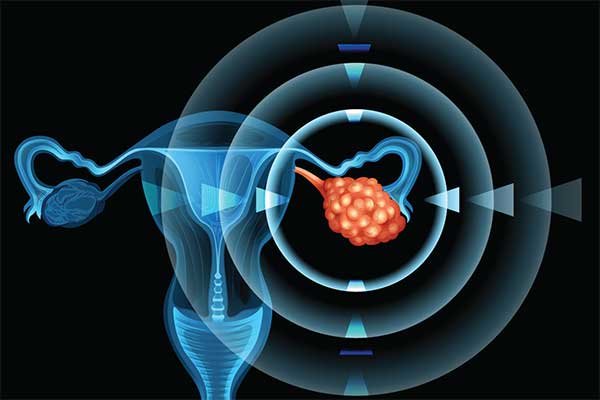Cancer can begin in any part of the body, and ovarian cancer is one of the many gynecological cancers that occur in women. The ovaries are a pair of organs in a woman’s pelvic region, one on either side of the uterus.
Depending upon the ovarian cells where the cancer begins, ovarian cancer can be of different types. Epithelial cell cancer is the most common ovarian cancer that begins in the epithelial cells lining the organ.
Though the exact cause of ovarian cancer is unknown, there is strong evidence to suggest that abnormal changes (mutations) in the DNA play a role. Since ovarian cancer affects every woman differently, the treatment plan must also be personalized to suit her needs. Let’s understand more about ovarian cancer treatment and the various options available that can help treat it.
Treatment Options for Ovarian Cancer
Ovarian cancer treatment depends upon several factors:
– The type and size of the cancer
– Location of the cancer
– Grade or aggressiveness of the cancer
– Extent of spread
– Patient’s overall health and well-being
The primary treatment options for ovarian cancer are surgery and chemotherapy. Other treatments now being used to treat these cancers include targeted drug therapy, immunotherapy, and hormone therapy.
Your doctor and multidisciplinary healthcare team will determine your treatment options based on the clinical features of your ovarian cancer.
- Surgery
Surgery is usually the first line of ovarian cancer treatment. In the case of early-stage ovarian cancers that have not spread outside the body, surgery helps to:
– remove one or both ovaries and fallopian tubes
– The cervix (opening to your womb from your vagina and the uterus
If ovarian cancer has spread to other body parts, additional surgery or other treatments may be required to kill the cancer cells. In some cases, surgery for ovarian cancer may involve the removal of the bowels.
In early-stage ovarian cancers, surgery can help cure the condition.
- Chemotherapy
Chemotherapy is a systemic treatment during which anti-cancer drugs are administered to reach all body areas. Chemotherapy drugs for ovarian cancer can be given intravenously, orally, or directly into the abdominal cavity.
In most ovarian cancer cases, chemotherapy involves administering a combination of two drugs given intravenously every three to four weeks, followed by a rest period. It is called a chemotherapy cycle. Ovarian cancer cases usually require three to six cycles, depending upon the stage of cancer.
- Radiotherapy
This treatment uses high-energy radiation to kill cancer cells and may be used for ovarian cancer in the following scenario:
– To treat advanced cancers when other treatments are not suitable
– Help alleviate symptoms like bleeding, pain, or discomfort in cases of advanced ovarian cancer
- Targeted Drug Therapy
While chemotherapy attacks rapidly dividing healthy cells along with the cancer cells, targeted therapy drugs are designed to target only the cancer cells without damaging or affecting the healthy ones. For this reason, targeted drug therapy can be more effective and cause fewer side effects than chemotherapy.
- Hormone Therapy
Hormone therapy is not a standard treatment option for ovarian cancers. It may be used for ovarian cancers that require hormones to grow. During hormone therapy, drugs that block hormones are administered to stop ovarian cancer from growing. Your doctor and multidisciplinary healthcare team will evaluate your condition and determine if hormone therapy is the right treatment.
- Immunotherapy
It is a biological therapy in which the body’s immune system is trained to identify and kill cancer cells. Since this treatment is relatively new for ovarian cancer, it may be combined with other treatments for added benefit.
Stage-Wise Treatment for Ovarian Cancer
Ovarian cancer treatment varies stage-wise and may include:
- Stage 1
Stage 1 ovarian cancers are early-stage and have not spread outside the ovaries. For this reason, they have the best outlook when treated in time. The standard line of treatment for stage 1 ovarian cancers is surgery to remove the tumor entirely.
The treatment after surgery depends upon the substage of cancer, involvement of lymph nodes, and other such factors. High-grade or stage 1B and 1C ovarian cancers may require chemotherapy or additional surgery in the future.
- Stage 2
Stage 2 ovarian cancers are spread from one ovary to the other and other parts of the pelvic region but not to nearby lymph nodes and other distant sites.
An individual with stage 2 ovarian cancer usually requires staging and debulking, a hysteroscopy followed by chemotherapy.
- Stage 3
Ovarian cancers spread outside the ovaries to other parts of the abdomen, lymph nodes, and a few distant sites and are said to be stage 3 cancers. Stage 3 ovarian cancers are treated like stage 2 cancers, but patients may require more cycles of chemotherapy in stage 3.
- Stage 4
When ovarian cancer spreads outside the abdomen, it is termed metastatic or stage 4 cancer. The treatment for stage 4 ovarian cancer depends upon the individual’s clinical condition and requirements. Chemotherapy is usually the first line of treatment for stage 4 ovarian cancers as it helps shrink the tumor to facilitate surgery and alleviate symptoms. In some cases, other treatment options may also be advised.
The Bottom Line
When diagnosed early, ovarian cancers are curable with a lesser recurrence rate. Several advances in ovarian cancer treatments have been made to improve outlook and prognosis. If you have been diagnosed with ovarian cancer, it is vital to understand the condition and make informed treatment decisions. Have queries? Ask our experts at Max Healthcare today!
Read More health Blogs About hernia meaning.
















